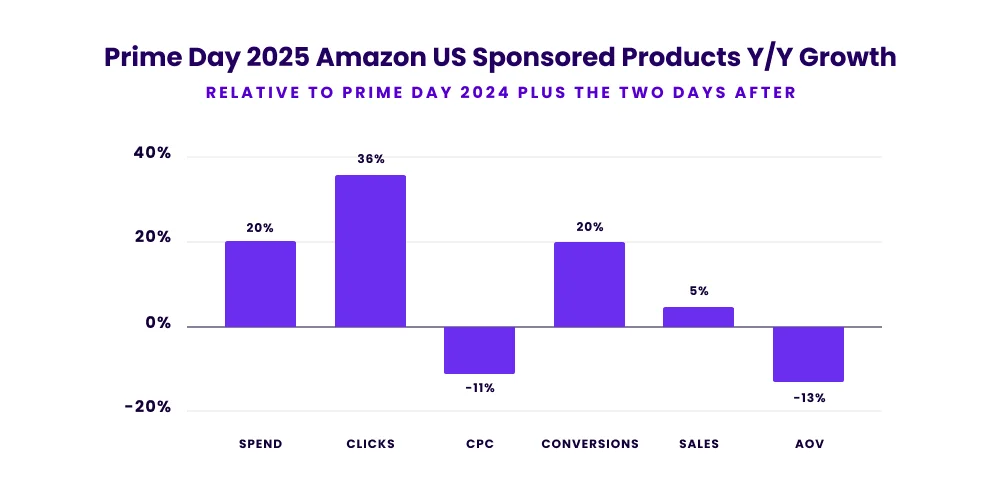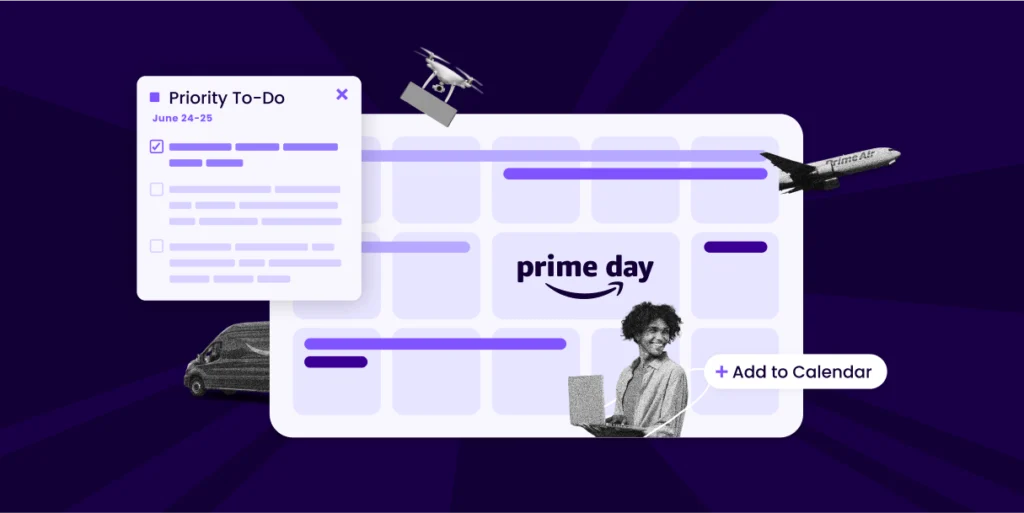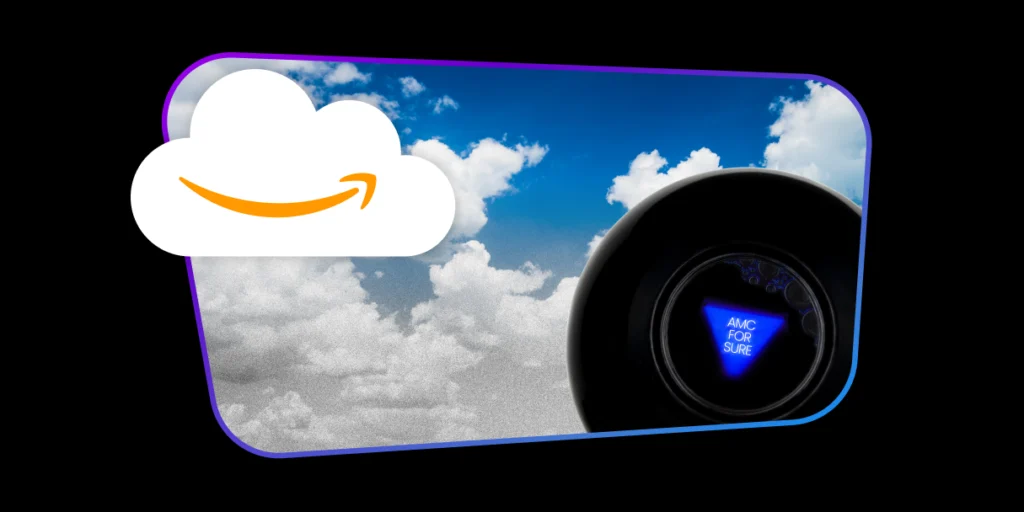Amazon Prime Day 2025: Results & Performance Data for Marketers
Jul 16 2025

Another year, another Prime Day for the books!
Advertisers are used to hearing how every Prime Day has beat the previous years’ record. Prime Day 2025 was no exception. The event’s duration doubled from two to four days, sales volume was up year-over-year, and advertiser spending reached new heights.
So, how did this twist on a classic sales holiday impact advertisers? We’ve tapped Andy Taylor to provide an exclusive research roundup covering topics such as:
- Prime Day’s influence on ad spend
- How two extra days influenced shopper behavior
- New customer acquisition performance
- Why click-through rates were up this year
Plus, we’ll provide a general recap of how Prime Day impacted advertisers on a day-by-day basis, using industry research mixed with our own experience. Ready to get all the details? Skip ahead using our table of contents, or just read on:
Table of Contents
What is Prime Day?
Prime Day is Amazon’s landmark sales holiday, taking the advertising world by storm every July since 2015. It was initially founded to celebrate Amazon’s 20th birthday, while helping encourage adoption and retention of Amazon Prime subscriptions. By flaunting some of the best deals of the year, Amazon has been able to sell tons of products, and even more ad space within their marketplace ecosystem.
The holiday was a clever idea. Before Prime Day, July was a notoriously slow month for retail sales. Memorial Day sales came and went, back-to-school shopping hadn’t taken hold yet, and holiday gift giving was nowhere near top-of-mind. This changed shortly after Amazon staked out their own summer shopping holiday. Now, advertisers, shoppers, and sellers alike look forward to Prime Day as a chance to raise awareness, generate sales, collect product reviews, and pilot marketing strategies for the upcoming Q4 holidays.
Prime Day is usually one or two days, but the event stretched into four days in 2025. This left advertisers scratching their heads (and maybe scrambling a bit to rework their strategies). While we can’t know for sure why Amazon extended the event, we assume there’s a few reasons:
- Trying to make a big splash to expand awareness – Prime Day is becoming passé to consumers. There’s a need to go bigger every year to keep winning headlines, and expanding the event is one way to do that.
- More opportunities to transact – Consumers are tightening their pursestrings, with the BEA finding a mere 1% growth in consumer spending during the first quarter of 2025. This can temper impulse buying, so adding a couple extra days for the “consideration” phase could be helpful.
- People are becoming seasoned Prime Day shoppers – Ten years has changed the summer sales environment. Consumers are more likely to have a multi-retailer purchasing strategy, increasing time spent researching deals. To compound the challenge, it seems almost every retailer has their own version of Prime Day now.
- Cutting the servers some slack – Maybe our Prime Day experts are wishcasting, but we noticed a distinct lack of bugs and downtime during Prime Day 2025 compared to previous years. Server issues don’t just mean potential disruptions to Amazon’s marketplace – they also tamper with ad buying and placement. Spreading web traffic across four days helped the shopper, seller, and advertiser experience go off without a hitch.
So, that might have been the rationale behind why we got a “Prime Week” this year. But you’re here to learn more about how this edition of the sales holiday actually played out, right? To explain that, we’re going to give a guest spot to our VP of Research, Andy Taylor.
How Was Advertiser Performance During Prime Day 2025?
contributed by

Prime Day 2025 came with no shortage of early data points making the rounds, and much ado was made from apples-to-oranges comparisons evaluating growth on the first day of a four-day event relative to the first day of a two-day event.
As the Tinuiti 2025 Amazon Prime Day Study detailed weeks ago, many Prime Day shoppers expected the four-day event to lead them to shop around more and make purchases later in the event than they otherwise would have. Thus, there was never a good reason to get too worked up about softer numbers in the early stages.
Here we’ll unpack what really happened to advertisers on Prime Day, looking at same-store growth metrics across ad formats to shed light on the impact of the four-day event and what advertisers should keep in mind for next year.
How Did Prime Day Impact Ad Spend and Conversions?
For Amazon’s flagship search ad format, Sponsored Products, spend rose 20% year over year comparing the entire four days of Prime Day 2025 to the two days of Prime Day 2024 plus the 48 hours that followed the event last year. Conversions attributed to Sponsored Products also rose 20%, as the cost of driving conversions held steady year over year.

Sales rose 5% year over year, with average order value falling 13% compared to Prime Day 2024. For the purpose of this rapid analysis, we use only 24-hour attribution in calculating conversions and sales to ensure that these values are fully populated.
Average cost per click (CPC) rose 12% year over year during Prime Day 2024, but the cost of ad clicks fell 11% during the 2025 event. CPC growth has been more muted for the last three quarters, averaging a 1% year-over-year decline over that stretch.
What Were The Most Impactful Days of Prime Day 2025?
Breaking down the share of sales attributed to Sponsored Products by day, the first 24 hours of the event accounted for 34% of attributed sales. The second and fourth days accounted for 23% each, with the third day driving the lowest sales volume at 19%.

This continues a trend observed over the years in which the first 24 hours of Prime Day account for the most sales. In 2024, the first day accounted for 55% of sales attributed to Sponsored Products, compared to 45% on the second day.
That said, days three and four are where Sponsored Products advertisers really started to see year-over-year growth come on. Sales jumped 310% on day three and 443% on day four, compared to more than 30% declines on each of the first two days.

Days three and four were up against weaker comparisons than the first two days since the event only lasted 48 hours last year, but that’s the nature of doubling the length of a sales event and giving shoppers more time to make decisions.
Thinking about how this should influence advertiser strategy if Amazon sticks with the four-day format in the future, it’s still important to come out of the gates strong to attract early shoppers. However, brands should remain active throughout the event to seize the full opportunity afforded by Prime Day.
With sales volume jumping from day three to day four, it’s clear that some shoppers waited until the homestretch to make purchases. Average order value increased on the last day, surpassing both days two and three, as shoppers appeared to put more consideration into larger purchases.
There’s also evidence that advertisers are more likely to acquire new customers in the later stages of the event.
How Many Prime Day Shoppers Were New-to-Brand in 2025?
Advertisers shouldn’t only be looking at raw sales volume as a measure of success, as the types of customers acquired can also be useful for assessing the value of big events like Prime Day. For example, new-to-brand shoppers offer a long-term revenue play through untapped customer lifetime value. With that in mind, many Prime Day advertisers want to reach new shoppers who haven’t bought from them before.
Looking at the share of new-to-brand conversions from Sponsored Brands Ads, the first day of Prime Day (62%) was very similar to the first day of the month (63%) for the median advertiser – so, it was a typical day for brands. However, the share of new-to-brand shoppers rose to 67% on day two before peaking at 70% on day three, falling slightly to 69% on the final day of the event.

Thus, not only did a decent share of Amazon Prime Day conversions come in the back half of the event, but conversions were also more than 10% more likely to be from new-to-brand customers than on the first day of Prime Day.
How Did Prime Day 2025 Impact Amazon DSP Ad Spend?
Same-store advertisers active on the Amazon DSP throughout Prime Day 2025 as well as Prime Day 2024 and the two days after increased spend 31% year over year, with a 46% increase in ad impressions and 10% decline in cost per thousand impressions (CPM).

As is typically the case, brands started ramping up DSP spend in the days leading up to Prime Day to warm up shoppers ahead of the event. DSP advertisers spent 56% more on average over the first seven days of July compared to the first seven days of June.

Prime video ads helped drive this increase in DSP investment both before and during Prime Day with many advertisers tapping into Amazon’s streaming video offering since it was launched in early 2024.

Looking at total Prime Video ad spend (not just same-store), spend jumped 91% year over year over the four days of Prime Day 2025 compared to Prime Day 2024 and the following two days. With impressions growing 108% year over year, advertisers saw average CPM fall 8%.
Were Shoppers More Likely to Click On Ads During Prime Day 2025?
One notable trend is that Sponsored Products clickthrough rate (CTR) rose 81% year over year compared to Prime Day 2024 and the two subsequent days. However, CTR has been up significantly throughout 2025, as advertisers saw a significant jump back in December of last year.

When CTR changes this much, it’s typically caused by Amazon updates to how and where ads are shown, rather than changes in shopper behavior. We saw this in the early days of the pandemic when Amazon significantly changed the mix of ads featured in different page locations, resulting in CTR rising more than 100% for advertisers.
In general, advertisers usually shouldn’t put too much stock in average CTR changes for Sponsored Products. These trends are often more reflective of platform changes.
How Did Prime Day Impact Google Shopping Results?
It’s been a relatively tumultuous year for Google Shopping auctions with Temu and Shein dropping out of them entirely in mid-April and Amazon pulling back sharply on its presence in Google Shopping Ads for a three-week period over late May through mid-June.
During Prime Day, however, Amazon’s competitors saw a familiar sight as Amazon’s share of Google Shopping impressions spiked to a high for the year.

Although Walmart and Target both held competing sales events that overlapped with Prime Day 2025, neither seemed to adjust their investment in Google Shopping auctions to a significant degree. At the same time, while Shein has returned to Google shopping listings, Temu largely remains on the sidelines with its competitors only seeing it pop up in Google’s listings sparingly in recent weeks.

With Amazon making such a large push for Google shopping impressions over Prime Day, its competitors in the Tinuiti client base saw their impressions fall by an average of 5% compared to the previous week.
Prime Day 2025 Recap
Additional insights contributed by Joe O’connor
Prime Day 2025 was off to a bit of an uncertain start. Media narratives swirled about a “soft start,” based on early agency data. But this year was completely different from previous years – most glaringly, this event was twice as long as previous years. Consumers were acutely aware of this, and didn’t feel the need to immediately pay up and check out.
Here’s some general information we’ve rounded up about Prime Day 2025’s general performance:
- Still the biggest sales holiday of the year. According to Adobe, Prime Day 2025 doubled the $10.8 billion that people spent on Black Friday last November. They also found online spending among U.S. retailers jumping by $24.1 billion during Prime Day 2025.
- Attention is split. Did you know 82% of Prime Day shoppers expected to browse products on at least one other marketplace during the event? It’s no surprise – deals were flying at them from every angle, with Target, Walmart, Wayfair, Best Buy, and even Kohls launching tentpole events during Prime Day.
- The people want discounts. Shoppers are feeling an economic squeeze, and will be discerning in their hunt for the best deals. 36% of this year’s Prime Day shoppers indicated they’ll need to see larger discounts than usual before deciding to make a purchase.
As you’ll read below, these factors contributed to an atypical, but still generally successful, Prime Day. Let’s take a closer look:
Day 1 Results
Prime Day 2025 kicked off on July 8th, with a mixed reception from thought leaders and media outlets. There were initial reports that sales had dropped 41% year-over-year, which spread like wildfire. While several publications used this to tee-up stories about a fall-from-grace while Amazon’s founder returns from a $50 million wedding, the reason behind the decline wasn’t very scandalous. Simply put, the length of the event influenced shopper behavior.
On our side, we saw a slight decline in ad spend year over year, while ad costs also fell. At the same time, Adobe released data showing that total retail spending was up 9.9% when comparing the first day of Prime Day 2025 to 2024’s numbers. So, this didn’t spell disaster. Rather, it was just one indication that savvy customers were browsing multiple retailers and eschewing impulse buys during a longer, four-day event.
This would be in line with what we found during our 2025 Prime Day Study. We found that 82% of Prime Day shoppers expected to browse products on at least one other marketplace during the event, and 41% expected to browse products on at least three other marketplaces. Then, consider that Target Circle Week ran from July 6th to 12th, and Walmart Deals for Days from July 8 to 11th. Consumers were spoiled for choice, and they knew it.
While Prime Day 1 delivered the highest volume of single-day sales during the event, it also functioned as a research day for many consumers. People were well-aware they had more time to consider their purchases, and more marketplaces to evaluate. But even if each day of Prime Day 2024 netted 41% fewer sales than 2025, Amazon would still break all of their previous sales records.
According to Joe O’Connor, our resident online marketplace expert, the trends highlighted during Day 1 underscores the importance of an advanced display strategy. As people research products, “there will be ample opportunity to retarget product detail page visitors during the event to convert those researchers into purchasers later on.”
Day 2 Results
Sales activity was still down on Day 2 of Prime Day, but Amazon remained on pace for a successful Prime Day. Advertisers rejoiced as their clickthrough rates increased (our data found CTRs of 0.34% vs 0.16% in 2024 for Apparel) while cost-per-click averages fell by 31%. However, we did find that Pet Supplies was exceptionally competitive this year, with clickthroughs and cost-per-click increasing 72.5% and 14%, respectively.
Clickthrough rates should be taken with a grain of salt – Like Andy mentioned previously, Amazon regularly updates their ad types, ad placements, and ad targeting capabilities, meaning it’s never an apples-to-apples comparison.
However, there are some interesting directional trends to glean here. Namely, Chewy seems to be one of the only retailers that sat out during the Prime Day frenzy. This may have funneled high-intent pet shoppers to Amazon, while pet brands moved Chewy to the back seat to better manage timely sales holidays.
Joe O’Connor had more wisdom to give Amazon sellers during day two:
Don’t let rumblings in the market today deter investment tomorrow. It was widely predicted that this year’s event would likely have lower daily average activity with the expansion of the event to 4 days, and that’s what feels slower. Overall, we should continue to see strong sales traffic today and tomorrow – so keep your campaigns budgeted, your discounts prepared, and your products fully in-stock for Days 3 and 4.
Day 3 Results
Traffic to Amazon slumped from Day 2 to Day 3 of Prime Day 2025, but the decline was more like a gentle slope than a sheer cliff. If Day 1 was about impulse purchases, then Day 2 and 3 were about deciding which items in their cart they’d like to commit to. Basically, shoppers were done with their utilitarian shampoo purchases, and were pondering if they should finally pick up an air fryer.
We found two major milestones took place during Day 3. First, CPCs for Sponsored Ads were finally on the rise as the event neared its end. Second, we saw ad spend and ad-attributed sales surpass 2024’s total on this day.
Regarding ad performance, Andy Taylor served us up some freshly baked insights:
While the first day is hugely important, days three and four are where Sponsored Products advertisers really started to see year-over-year growth come on. Sales jumped 310% year over year on day three and 443% on day four, compared to more than 30% declines on each of the first two days. Conversions were also more than 10% more likely to be from new-to-brand customers over the last two days than on the first day of Prime Day.
Day 4 Results
On Friday, July 11th, Prime Day 2025 drew to a close. All of the pent up demand from the past week came out on Friday as people decided what they’d purchase, and what they’d end up taking out of the cart for now. It’s a typical story of procrastination, waiting until the last minute to submit your order or miss the deadline.
Looking back at our 2025 Prime Day Study, we want to revisit two datapoints: 31% of respondents said they expect to spend more on Amazon during the four-day event, and 80% of Prime members surveyed expected to shop the deals, an increase of 12% year over year.
Our research also found that while total ad-attributed Amazon sales were 5% year-over-year, which is consistent with more people planning to shop on Amazon, the average order value was down 13%. With a longer consideration period, you’d expect a higher order value.
Some shoppers did splurge – Adobe found online sales of appliances and electronics nearly doubled when compared to average daily sales in June. However, Amazon’s overall Prime Day performance is indicative of emerging consumer trends. Consider this information that we found during our 2025 Prime Day Study:
- Asked how higher US tariffs will impact their Prime Day shopping, 36% of respondents planning to shop this year indicated they’ll need to see larger discounts than usual.
- Tariffs are set to drive 32% of Prime Day shoppers to stock up on products that are expected to be more expensive later in the year.
- At the same time, some Amazon sellers held back on deep discounts since tariffs made product manufacturing more expensive – influencing their ability to turn a profit and prevent stockouts.
While nobody has a crystal ball, this seems to be in line with some of the predictions made during our earlier exploration into the 2025 tariff landscape. Consumers and brands alike are becoming increasingly price sensitive – and when consumers didn’t see the discounts they were hoping for, they might have just decided to tighten their belts and save more cash for the upcoming holiday season.
Is Prime Day 2025 Finally Over?
Overall, this Prime Day was a success for Amazon by almost every metric – especially when considering economic headwinds. However, the success of your Prime Day has yet to be seen.
“Isn’t Prime Day over, though?” You might think to yourself. Not quite – Prime Day is really just a practice run for your Q4 and holiday marketing campaigns. Not only that, you might have forgotten to do a few things:
- Go into the ad console and make sure you’ve readjusted your bids to pre-Prime Day levels.
- Prepare cross-sell strategies. Okay, you sold a bunch of pillows during Prime Day. What are the chances that customers will realize they need more pillowcases in the coming weeks?
- Don’t forget to retarget cart abandoners in the next 90 days and throughout the holiday shopping season. Chances are, they’re still interested – the timing or discount just wasn’t right.
Prime Day is a tentpole event that is going to set up your brand’s success for the rest of the year. If you played your cards right, you won a lot of new-to-brand customers throughout the week, and collected even more delicious data about how customers are shopping amid economic turbulence. Both of these will be critical to future-proofing your marketing efforts.
Before you go…
Maybe Prime Day 2025 was a smashing success for your brand. Or, maybe Prime Day taught you some tough lessons.
The good news: You can flip those shortcomings into a winning strategy.
Wondering how it works? Sign up for our upcoming webinar, What Prime Day Tells Us About Q4 & How to Win It. You’ll get more research and practical tactics from Joe and Andy, including:
- Which parts of your Prime Day strategy worked, and which parts didn’t?
- How can you fine-tune your pricing this holiday season?
- Where should you advertise products to build demand ahead of the holidays?
We’re even going to have a live Q&A at the event – so show up on time, and you’ll get unique insights catered to your exact business challenges. RSVP here!
You Might Be Interested In














